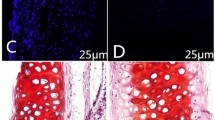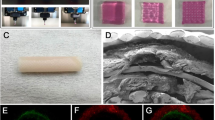Abstract
Purpose
We studied the regenerated cartilage in tracheal defect repair and compared the bio-materials used versus native trachea using basic fibroblast growth factor (bFGF)-impregnated gelatin hydrogel.
Materials and methods
A full-thickness anterior defect was created in the cervical trachea of 15 experimental rabbits. The defect was implanted with a hybrid scaffold of poly(lactic-co-glycolic acid) (PLGA) knitted mesh and collagen sponge. The implanted trachea was reinforced with a copolymer stent of polycaprolactone and poly(lactic acid) coarse fiber mesh. A gelatin hydrogel was used for providing a sustained release of bFGF. The reconstructed tracheas were divided into three groups with wrapped materials; without gelatin hydrogel (control group, n = 5), a gelatin hydrogel with saline (gelatin group, n = 5), and a gelatin hydrogel with 100 μg of bFGF (bFGF group, n = 5). One of the five rabbits in each group at 1 month after operation, one at 3 months, and three at 6 months were killed and the engineered tracheas were evaluated histologically. Biomechanical properties were evaluated on samples at 6 months postoperatively.
Results
The rigid support in the defect portion was maintained during 6 months postoperatively. The newly regenerated cartilages were recognized between the host cartilage stumps at 3 months postoperatively in the bFGF group, and limited new cartilage growth and epithelialization were observed at 6 months postoperatively.
Conclusions
The experiment shows that using bFGF, better mechanical strength was obtained but with poor cartilage growth.




Similar content being viewed by others
References
Okumura N, Nakamura T, Natsume T, Tomihata K, Ikada Y, Shimizu Y (1994) Experimental study on a new tracheal prosthesis made from collagen-conjugated mesh. J Thorac Cardiovasc Surg 108:337–345
Yamashita M, Kanemaru S, Hirano S et al (2007) Tracheal regeneration after partial resection: a tissue engineering approach. Laryngoscope 117:497–502
Nakamura T, Sato T, Araki M et al (2009) In situ tissue engineering for tracheal reconstruction using a luminar remodeling type of artificial trachea. J Thorac Cardiovasc Surg 138:811–819
Omori K, Nakamura T, Kanemaru S et al (2005) Regenerative medicine of the trachea: the first human case. Ann Otol Rhinol Laryngol 114:429–433
Sato T, Araki M, Nakajima N, Omori K, Nakamura T (2010) Biodegradable polymer coating promotes the epithelization of tissue-engineered airway prostheses. J Thorac Cardiovasc Surg 139:26–31
Chen G, Sato T, Ushida T, Hirochika R, Tateishi T (2003) Redifferentiation of dedifferentiated bovine chondrocytes when cultured in vitro in a PLGA–collagen hybrid mesh. FEBS Lett 8(542):95–99
Chen G, Sato T, Ushida T et al (2003) The use of a novel PLGA fiber/collagen composite web as a scaffold for engineering of articular cartilage tissue with adjustable thickness. J Biomed Mater Res A 15(67):1170–1180
Chen G, Sato T, Ushida T, Ochiai N, Tateishi T (2004) Tissue engineering of cartilage using a hybrid scaffold of synthetic polymer and collagen. Tissue Eng 10:323–330
Chen G, Liu D, Tadokoro M et al (2004) Chondrogenic differentiation of human mesenchymal stem cells cultured in a cobweb-like biodegradable scaffold. Biochem Biophys Res Commun 322:50–55
Korpela A, Aarnio P, Sariola H, Törmälä P, Harjula A (1988) Comparison of tissue reactions in the tracheal mucosa surrounding a bioabsorbable and silicone airway stents. Ann Thorac Surg 66:1772–1776
Robey TC, Välimaa T, Murphy HS, Tôrmâlâ P, Mooney DJ, Weatherly RA (2000) Use of internal bioabsorbable PLGA “finger-type” stents in a rabbit tracheal reconstruction model. Arch Otolaryngol Head Neck Surg 126:985–991
Aikawa M, Miyazawa M, Okada K et al (2007) Regeneration of extrahepatic bile duct—possibility to clinical application by recognition of the regenerative process. J Smooth Muscle Res 43:211–218
Tabata Y, Nagano A, Muniruzzaman M, Ikada Y (1998) In vitro sorption and desorption of basic fibroblast growth factor from biodegradable hydrogels. Biomaterials 19:1781–1789
Tabata Y, Nagano A, Ikada Y (1999) Biodegradation of hydrogel carrier incorporating fibroblast growth factor. Tissue Eng 5:127–138
Isogai N, Morotomi T, Hayakawa S et al (2005) Combined chondrocyte-copolymer implantation with slow release of basic fibroblast growth factor for tissue engineering an auricular cartilage construct. J Biomed Mater Res A 74:408–418
Igai H, Chang SS, Gotoh M et al (2006) Regeneration of canine tracheal cartilage by slow release of basic fibroblast growth factor from gelatin sponge. ASAIO J 52:86–91
Tatekawa Y, Ikada Y, Komuro H, Kaneko M (2010) Experimental repair of tracheal defect using a bioabsorbable copolymer. J Surg Res 160:114–121
Chen G, Ushida T, Tateishi T (2000) A hybrid network of synthetic polymer mesh and collagen sponge. Chem Commun 16:1505–1506
Chen G, Ushida T, Tateishi T (2002) Scaffold design for tissue engineering. Macromol Biosci 2:67–77
Suzuki T, Kobayashi K, Tada Y et al (2008) Regeneration of the trachea using a bioengineered scaffold with adipose-derived stem cells. Ann Otol Rhinol Laryngol 117:453–463
Nomoto Y, Suzuki T, Tada Y et al (2006) Tissue engineering for regeneration of the tracheal epithelium. Ann Otol Rhinol Laryngol 115:501–506
Igai H, Chang SS, Gotoh M et al (2009) Widespread and early tracheal cartilage regeneration by synchronous slow release of b-FGF and BMP-2. ASAIO J 55:266–270
Kojima K, Bonassar LJ, Ignotz RA, Syed K, Cortiella J, Vacanti CA (2003) Comparison of tracheal and nasal chondrocytes for tissue engineering of the trachea. Ann Thorac Surg 76:1884–1888
Weidenbecher M, Tucker HM, Awadallah A, Dennis JE (2008) Fabrication of a neotrachea using engineered cartilage. Laryngoscope 118:593–598
Acknowledgments
The authors thank Kouki Hagiwara for their expert technical assistance in these experiments. This work was supported by a Grant-in-Aid for Exploratory Research and a Grant-in-Aid for Scientific Research (KAKENHI) from the Japan Society for the Promotion of Science (19659457).
Author information
Authors and Affiliations
Corresponding author
Rights and permissions
About this article
Cite this article
Tatekawa, Y., Kawazoe, N., Chen, G. et al. Tracheal defect repair using a PLGA–collagen hybrid scaffold reinforced by a copolymer stent with bFGF-impregnated gelatin hydrogel. Pediatr Surg Int 26, 575–580 (2010). https://doi.org/10.1007/s00383-010-2609-2
Accepted:
Published:
Issue Date:
DOI: https://doi.org/10.1007/s00383-010-2609-2




